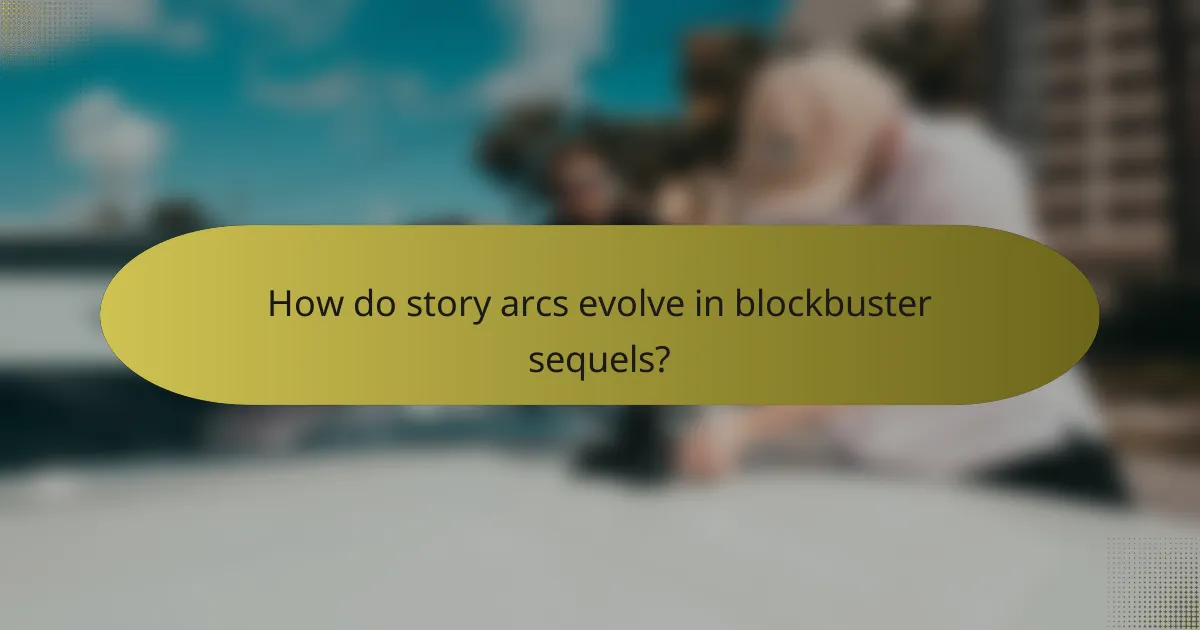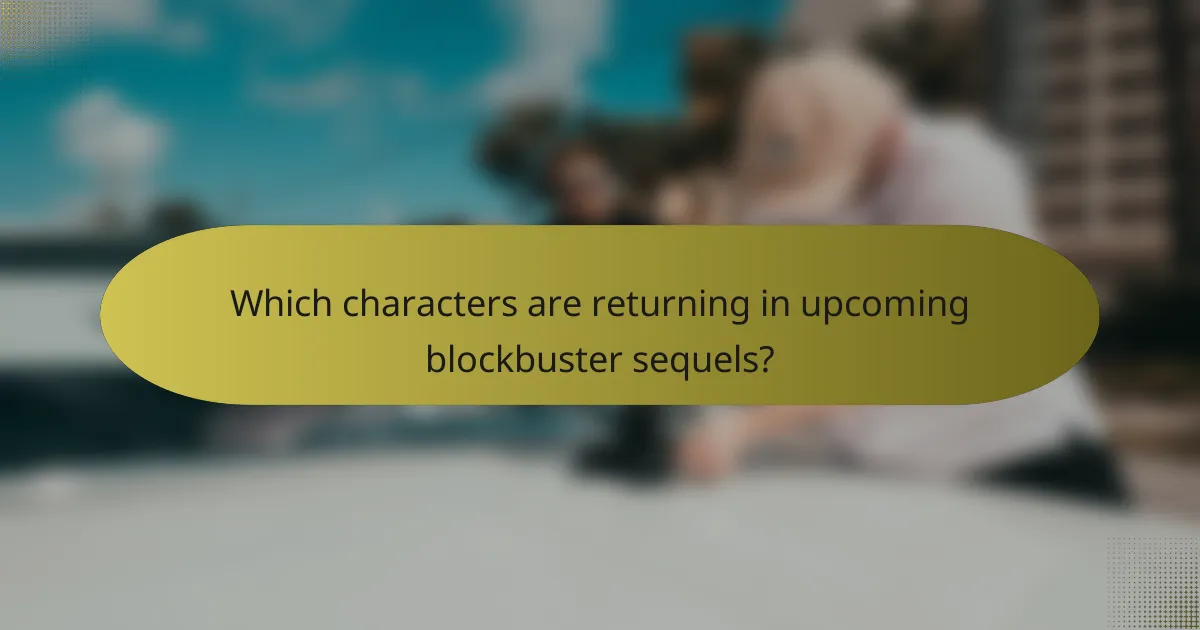The article focuses on the release dates for blockbuster sequels, examining how these dates can change due to production schedules, studio decisions, and market conditions. It discusses the evolution of story arcs in sequels, highlighting how they deepen character development and introduce new challenges and characters. Additionally, the article addresses the uncertainty surrounding returning characters and explores popular fan theories about potential plot developments and character twists. Overall, it provides a comprehensive overview of the dynamics involved in blockbuster sequels, including continuity, innovation, and audience engagement.

What are the upcoming release dates for blockbuster sequels?
It is not possible to provide a definitive answer regarding the upcoming release dates for blockbuster sequels. Release dates are subject to change based on production schedules, studio decisions, and external factors such as market conditions. Therefore, it is best to consult official movie industry sources or announcements for the most accurate and updated information on specific sequels.
How do release dates impact audience anticipation for sequels?
Release dates significantly impact audience anticipation for sequels. A well-timed release can create excitement and maintain momentum from the previous film. For example, sequels released within two to three years of their predecessors often benefit from heightened interest. This is due to the continuity of the narrative and characters, which keeps the audience engaged. Conversely, extended gaps can lead to diminished interest and outdated cultural relevance. Historical data shows that sequels like “Star Wars: The Force Awakens,” released ten years after “Revenge of the Sith,” generated massive anticipation due to strategic timing. Additionally, marketing campaigns aligned with release dates amplify audience engagement through teasers and trailers. These factors collectively enhance the overall anticipation for sequels among fans.
What factors influence the scheduling of blockbuster sequels?
The scheduling of blockbuster sequels is influenced by several key factors. These include the performance of the original film, audience demand, and availability of cast and crew. Box office success is a primary driver; high earnings often lead to quicker sequel planning. Audience interest is gauged through surveys and social media engagement. Timing is also critical; studios consider release windows to avoid competition. Production schedules must align with the availability of key talent, which can delay or expedite sequels. Additionally, franchise continuity and story development play significant roles in determining the right moment for a sequel’s release.
How do studios decide on release windows for sequels?
Studios decide on release windows for sequels by analyzing market trends and audience demand. They assess the performance of the original film to gauge potential interest. Timing is crucial; studios often target specific seasons, such as summer or holidays, for maximum box office impact. Competitive analysis informs decisions, as studios consider other films releasing around the same time. Additionally, they evaluate production schedules and the availability of key talent. Historical data on previous sequels also plays a role in determining optimal release dates. For example, sequels that performed well during certain months may be scheduled similarly.
What are the major blockbuster sequels set to be released in the next few years?
Upcoming major blockbuster sequels include “Avatar 3,” scheduled for December 2024. “Avatar 4” follows in December 2026. “Guardians of the Galaxy Vol. 3” is set for May 2023. The “Fast & Furious 11” is expected in May 2024. “Mission: Impossible 8” is slated for July 2025. “Wonder Woman 3” is also in development, with no confirmed release date yet. These sequels are highly anticipated due to their successful predecessors and established fan bases.
Which sequels have confirmed release dates?
It is currently not possible to provide a definitive list of sequels with confirmed release dates. The landscape of film production is constantly changing. New announcements are made frequently and dates can shift. For the most accurate information, consult reliable entertainment news sources.
What sequels are currently in development with tentative release dates?
Currently, several sequels are in development with tentative release dates. “Avatar 3” is scheduled for December 2025. “Guardians of the Galaxy Vol. 4” is expected to release in 2026. “Fantastic Beasts 4” is tentatively set for 2025. “The Matrix 5” is also in early development, with no specific date announced yet. These projects reflect ongoing interest in established franchises.

How do story arcs evolve in blockbuster sequels?
Story arcs in blockbuster sequels often evolve by expanding on the original narrative. Sequels typically introduce new challenges for characters, deepening their development. They may explore backstories that were previously hinted at, providing context for character motivations. Additionally, sequels often introduce new characters who impact the existing storyline. This can create fresh dynamics and conflicts.
The stakes are usually raised in sequels, leading to more intense plot developments. For example, sequels may shift from personal conflicts to larger, world-threatening scenarios. This evolution keeps audiences engaged and invested in the characters’ journeys.
Successful sequels often balance nostalgia with innovation, referencing the original while offering new experiences. This approach has been seen in franchises like “Star Wars” and “Marvel Cinematic Universe.” These films effectively build upon their predecessors, ensuring continuity while expanding the universe.
What are common themes in story arcs of blockbuster sequels?
Common themes in story arcs of blockbuster sequels include character development, escalating stakes, and nostalgia. Character development often shows protagonists facing new challenges that test their growth. Escalating stakes typically involve larger conflicts or threats compared to the original film. Nostalgia is frequently utilized to connect with audiences through familiar elements from the first installment. Additionally, sequels may explore themes of legacy and family, as seen in franchises like “Star Wars” and “Fast & Furious.” These themes help maintain viewer engagement and create emotional resonance across installments.
How do sequels build on the original film’s narrative?
Sequels build on the original film’s narrative by expanding existing storylines and character arcs. They often continue the journey of protagonists, introducing new challenges and conflicts. This allows for deeper character development and exploration of themes. Sequels frequently reference events from the original film, creating a cohesive universe. They may also introduce new characters who interact with established ones, enriching the narrative. For example, “The Godfather Part II” delves into the backstory of Vito Corleone while advancing Michael’s storyline. This layered storytelling enhances audience engagement and emotional investment.
What new elements are typically introduced in sequel story arcs?
Sequel story arcs typically introduce new characters and expanded settings. These new characters often serve as allies or antagonists, enhancing the narrative complexity. Expanded settings provide fresh environments for the plot to unfold. They can introduce new themes and conflicts that were not present in the original. Additionally, sequels often explore deeper character development for returning characters. This can lead to new relationships and dynamics. New plot twists are also common, keeping the audience engaged. These elements aim to build on the original story while offering something fresh and exciting.
Why do audiences care about the evolution of story arcs in sequels?
Audiences care about the evolution of story arcs in sequels because it shapes their emotional investment in characters and plots. A well-developed story arc can create deeper connections between the audience and the narrative. This evolution often reflects character growth and thematic development, enhancing viewer engagement. For instance, sequels that build upon established arcs can provide satisfying resolutions or unexpected twists. Research shows that narratives with evolving arcs maintain audience interest, as they introduce new challenges and stakes. According to a study by the University of Southern California, sequels with complex story arcs tend to perform better at the box office, indicating audience preference for depth in storytelling.
How do character development and plot twists affect viewer engagement?
Character development and plot twists significantly enhance viewer engagement. Well-developed characters create emotional connections with the audience. This connection leads to increased investment in their journeys. Plot twists introduce unexpected elements that maintain interest and surprise viewers. They challenge audience expectations and provoke discussions. Studies show that narratives with strong character arcs and surprising twists are more memorable. For instance, a study by the University of Southern California found that viewers are more likely to recall and discuss films with complex characters and unexpected plot developments. This engagement often translates into higher ratings and repeat viewership.
What role does nostalgia play in the reception of sequel story arcs?
Nostalgia significantly influences the reception of sequel story arcs. It evokes emotional connections to original content, enhancing audience engagement. This emotional resonance can lead to increased anticipation for sequels. Research indicates that familiar elements from original stories often draw viewers back. For example, the return of beloved characters can trigger fond memories. This phenomenon can boost box office performance and critical reception. Studies show that sequels leveraging nostalgia tend to perform better in audience ratings. The combination of nostalgia and familiarity creates a compelling narrative experience.

Which characters are returning in upcoming blockbuster sequels?
It is currently unclear which specific characters are returning in upcoming blockbuster sequels. The information about returning characters often depends on announcements from studios and production companies. Many sequels typically bring back popular characters from their original films. However, without official announcements, it is not possible to provide a definitive list of returning characters.
What factors determine which characters return for sequels?
Character return in sequels is determined by narrative necessity, actor availability, and audience demand. Narrative necessity ensures that returning characters are integral to the story progression. Actor availability can influence character return based on scheduling and contract negotiations. Audience demand is assessed through box office performance and fan engagement. Historical data shows that franchises often prioritize popular characters to maximize viewer interest. For example, the “Fast & Furious” series consistently brings back central characters due to their strong fan following.
How does the return of original cast members influence fan expectations?
The return of original cast members significantly raises fan expectations. Fans often associate original cast members with the authenticity and charm of the initial production. Their presence can evoke nostalgia and a sense of continuity. This can lead to heightened anticipation for the storyline and character development. For example, the return of original actors in franchises like “Star Wars” and “Jurassic Park” generated increased excitement and speculation among fans. Studies have shown that familiar characters can enhance viewer engagement and loyalty. Thus, original cast members play a crucial role in shaping fan expectations for sequels.
What new characters are being introduced alongside returning favorites?
It is not possible to provide an answer to the question regarding new characters being introduced alongside returning favorites without specific context or details about the particular blockbuster sequel in question.
How do returning characters shape the narrative in sequels?
Returning characters shape the narrative in sequels by providing continuity and emotional resonance. They connect the audience to the original story, reinforcing established themes. Their development often reflects the changes that occurred in the original narrative. This evolution can create new conflicts and deepen character arcs. Familiarity with these characters can enhance viewer investment in the sequel’s plot. Research indicates that sequels featuring returning characters tend to perform better at the box office. For example, films like “Toy Story 3” and “The Dark Knight Rises” demonstrate this trend. Returning characters can also evoke nostalgia, prompting audience engagement. Their presence helps to bridge the gap between the original film and the sequel, ensuring a cohesive storytelling experience.
What are the implications of character arcs for returning characters?
Character arcs for returning characters significantly impact narrative continuity and audience engagement. They provide a sense of growth or regression, influencing how viewers perceive the character’s journey. Returning characters can either reinforce established traits or introduce new complexities. This duality can create tension or resolution in the storyline. For example, if a character overcomes past flaws, it can resonate with audiences seeking redemption themes. Conversely, a character reverting to previous behaviors may evoke frustration or disappointment. This dynamic shapes audience expectations and emotional investment in the sequel. Overall, character arcs are crucial for maintaining consistency while allowing for fresh storytelling opportunities.
How do returning characters connect to the themes of the sequel?
Returning characters often embody the core themes of a sequel. They provide continuity and emotional resonance. Their development reflects the growth or changes in the narrative’s central themes. For example, a character’s struggles may mirror the sequel’s exploration of redemption or loss. Their interactions with new characters can highlight key thematic contrasts. This dynamic enriches the story by deepening the audience’s understanding of the themes. Consequently, returning characters serve as anchors that connect the audience to the sequel’s overarching message.

What fan theories are circulating about upcoming blockbuster sequels?
Fan theories about upcoming blockbuster sequels include various speculative ideas. For instance, many fans believe that a key character will return in a surprising twist. Some theorize that the sequel will explore alternate timelines or dimensions. Others suggest that unresolved plot points from previous films will be addressed. Additionally, there are theories about unexpected alliances forming between characters. Fans often base their theories on clues from trailers or social media posts by the creators. Popular franchises like Marvel and Star Wars frequently inspire such speculation. These theories contribute to the excitement surrounding upcoming releases.
How do fan theories enhance the excitement for sequels?
Fan theories enhance the excitement for sequels by engaging audiences in speculation and discussion. They create a sense of community among fans who share their interpretations. This interaction can lead to heightened anticipation for the sequel’s release. Fans often analyze plot details and character arcs from previous installments. Theories can generate buzz on social media platforms, amplifying interest. Additionally, filmmakers sometimes incorporate fan theories into the narrative, validating audience engagement. This creates a dynamic relationship between creators and fans. Ultimately, fan theories can significantly influence marketing strategies for upcoming sequels.
What are some popular fan theories for specific blockbuster sequels?
One popular fan theory for “Star Wars: The Last Jedi” suggests that Rey is a Kenobi. This theory is supported by her strong connection to the Force and her fighting skills. Fans point to her lineage as a potential twist in the story. Another theory for “Jurassic World: Dominion” proposes that the dinosaurs will evolve further. This is based on the concept of natural selection and adaptation over time. In “Avengers: Endgame,” many fans theorize that Captain America returns to an alternate timeline. This theory stems from the complexities of time travel presented in the film. For “Toy Story 4,” a theory suggests that the new character Forky represents the existential crisis of toys. This reflects the overarching theme of identity in the series. Each of these theories has sparked extensive discussion among fans, showcasing their engagement with the narratives.
How do these theories reflect audience engagement with the franchise?
Audience engagement with the franchise is reflected in the theories through active participation and interpretation. Fans analyze story arcs and returning characters to create theories. These theories often generate discussions on social media and fan forums. The more intricate the theories, the deeper the engagement. For example, theories that connect plot points across sequels indicate a dedicated fan base. Research shows that franchises with robust fan theories often experience higher box office returns. This correlation demonstrates the significance of audience involvement in shaping franchise narratives.
What role do fan theories play in shaping the narrative expectations?
Fan theories significantly influence narrative expectations in media. They create anticipation and speculation among audiences. Fans analyze clues and inconsistencies within stories. This analysis leads to a collective understanding of potential plot developments. As theories gain traction, they can shape creators’ decisions. Writers may incorporate popular theories to meet audience expectations. This interaction enhances viewer engagement and investment in the narrative. Research shows that fan engagement can lead to increased viewership and loyalty.
How do studios respond to fan theories before a sequel’s release?
Studios often engage with fan theories before a sequel’s release through various strategies. They may utilize social media platforms to gauge audience sentiment and reactions. Studios sometimes release teasers or hints that subtly address popular theories. This can create buzz and maintain audience interest. Additionally, they may choose to remain silent to preserve plot twists and surprises. Engaging with fan theories can enhance community involvement and anticipation. For example, during the lead-up to “Star Wars: The Force Awakens,” Lucasfilm shared cryptic images that fueled fan speculation. This approach can lead to increased excitement and discussion around the film.
What impact do fan theories have on the marketing of blockbuster sequels?
Fan theories significantly influence the marketing of blockbuster sequels. They generate buzz and anticipation among audiences. Theories often create a sense of community among fans. This engagement can lead to increased social media discussions and sharing. Marketers leverage fan theories to tailor promotional content. They may incorporate popular theories into trailers or marketing campaigns. This strategy boosts viewer interest and ticket sales. For example, theories surrounding the “Star Wars” franchise have driven extensive marketing efforts. These efforts capitalize on fan speculation to enhance viewer engagement and excitement.
What tips can fans use to stay updated on blockbuster sequels?
Fans can stay updated on blockbuster sequels by following official movie websites and social media channels. These platforms often share news about release dates and casting updates. Subscribing to entertainment news outlets provides timely information on upcoming sequels. Joining fan forums and discussion groups can also yield insights and rumors from fellow enthusiasts. Utilizing movie tracking apps helps fans receive notifications about release dates and trailers. Additionally, attending comic conventions or film festivals can offer exclusive previews and announcements. Keeping an eye on industry publications ensures awareness of behind-the-scenes developments.
The main entity of this article is the release dates for blockbuster sequels, focusing on their story arcs, returning characters, and fan theories. The article provides an overview of how release dates affect audience anticipation, factors influencing scheduling, and major sequels set to be released in the coming years. It also discusses the evolution of story arcs in sequels, the significance of character development, and the impact of nostalgia on viewer engagement. Additionally, the article highlights the role of fan theories in shaping narrative expectations and marketing strategies for upcoming films.